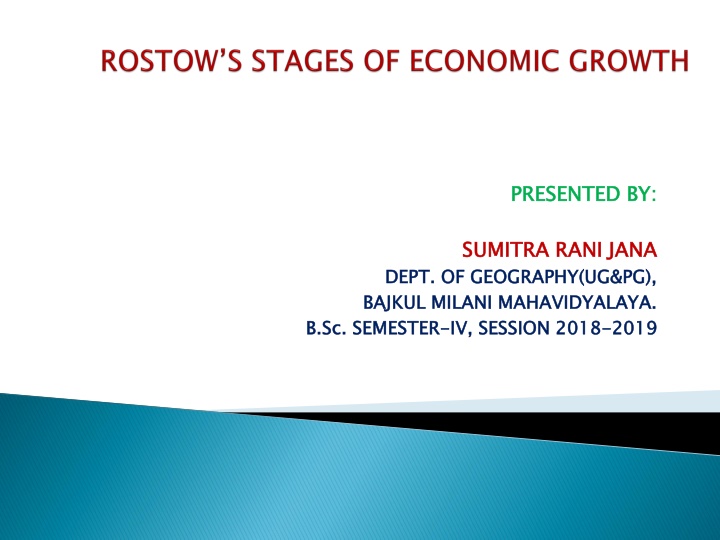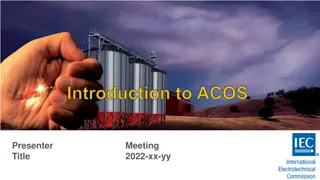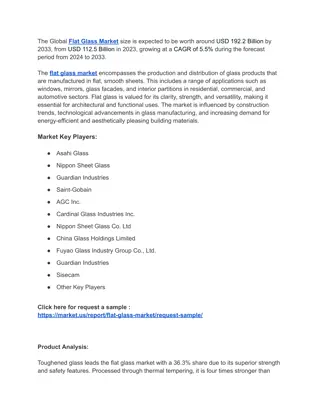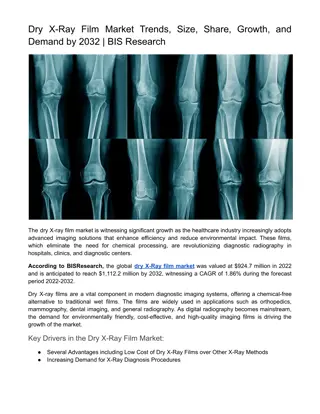
Rostow's Stages of Economic Growth Model and Societal Evolution
Explore the evolution of societies through Rostow's Stages of Economic Growth Model, from traditional societies to modern economic development. The model outlines key stages such as Traditional Society, Take-off, Drive to Maturity, and High Mass Consumption, highlighting shifts in agriculture, technology, social structures, and national identity. Witness the journey of countries transitioning from feudalism to industrialization and urbanization, driving economic progress and societal change.
Download Presentation

Please find below an Image/Link to download the presentation.
The content on the website is provided AS IS for your information and personal use only. It may not be sold, licensed, or shared on other websites without obtaining consent from the author. If you encounter any issues during the download, it is possible that the publisher has removed the file from their server.
You are allowed to download the files provided on this website for personal or commercial use, subject to the condition that they are used lawfully. All files are the property of their respective owners.
The content on the website is provided AS IS for your information and personal use only. It may not be sold, licensed, or shared on other websites without obtaining consent from the author.
E N D
Presentation Transcript
PRESENTED BY: PRESENTED BY: SUMITRA RANI JANA DEPT. OF GEOGRAPHY(UG&PG), BAJKUL MILANI MAHAVIDYALAYA. B.Sc. SEMESTER SUMITRA RANI JANA DEPT. OF GEOGRAPHY(UG&PG), BAJKUL MILANI MAHAVIDYALAYA. B.Sc. SEMESTER- -IV, SESSION 2018 IV, SESSION 2018- -2019 2019
Rostows Stages of Economic Growth model is one of the major historical models of economic growth. It was published by American economist walt Whitman Rostow in 1960. The model postulates that economic growth occurs in five basic stages of varying length- a. b. The pre conditions of take-off c. d. Drive to maturity e. Traditional Society Take off High mass consumption
The whole of the pre-Newtonian world consisted of such societies as the dynasties of China, civilisations of the Middle East, the Mediterranean and Medieval Europe. Characterized by subsistence agriculture or hunting and gathering, almost wholly a Primary sector economy. Limited technology Very little mobility or social change, great divisions of wealth and decentralised political power. Exceptions to the pattern of emergence from the traditional state are those countries which Rostow described as being Born Free like USA and certain British Dominions. For the rest of the world change consisted of economic transformation as well as political and social transition from feudalism.
This is the stage between the feudalism and take of stage. External demand for raw materials initiates economic change Development of more productive, commercial agriculture and cash crops not consumed by producers and largely exported. Widespread and enhanced investment in changes to the physical environment to expand production(i.e. Irrigation, canals, ports). Increasing spread of technology and advances in existing technologies. Changing social structure, with previous social equilibrium now in flux Individual social mobility begins Development of national identity and shared economic interests.
Urbanization increases, industrialization proceeds, technological breakthroughs occur. Secondary (goods-producing) sector expands and ratio of secondary vs. Primary sectors in the economy shifts quickly towards secondary. Textiles and apparel are usually the first take off industry as happened in Great Britain s classic Industrial Revolution An example of the Take off phase is the Agriculture(Green) Revolution in the 1960s. The rate of productive investment should rise from approximately 5% to over 10% of national income or net national product. The development of one or more substantial manufacturing sectors, with a high rate of growth.
Country Country Take Take of Period of Period Great Britain 1783-1802 Russia 1890-1914 United states 1843-1860 Germany 1850-1873 Canada 1896-1914 China 1952 India 1952
It refers to the period when society has successfully applied the range of modern technology to the bulk of its resources. During this period new leading sectors replace the old and Rastow has seen that development of the steel industry as a symbol of Maturity. America, Germany, France and UK entered the stage of maturity together. Changes in the industrial structure is expected to be accompanied by the following changes in the society- i. Changes in the distribution of work force. ii. Growth of the urban population. iii. Increase in the proportion of white collar workers. iv. Switch in the industrial leadership from the entrepreneur to the manager. Maturity has political features as well. Nations are expected to grow confident and exert themselves. It has to choose between high mass consumption, the building of a welfare state or imperialist ends
According to Rostow ultimately every nation will reach the stage of high mass consumption which ever path it chooses during maturity. This stage is likely to be characterised by the production of variety of consumer goods accompanied by the advertisement culture. Consumers typically (if not universally), have disposable income, beyond all basic needs, for additional goods. Urban society (a movement away from rural country sides to the cities)
Rostows model has been criticised by economists and social scientists belonging to other disciplines. i. Traditional society is not a pre-requisite qualification for development. Countries like the USA, Canada, Australia, and New Zealand were not traditional when they were born. ii. The precondition phase is not necessary before the take off. It is hard to believe on the available evidence that a phase of agricultural revolution and build up of overhead social capital in transport must precede the take off. iii. Stages tend to overlap. Countries such as New Zealand and Denmark experienced take off as a result of agricultural development. In their cases, the different stages postulated by Rostow are not Distinct. iv. Rostow s emphasis on the role of some leading sectors like textile, railroad, etc,. In the take off can hardly be proves.









